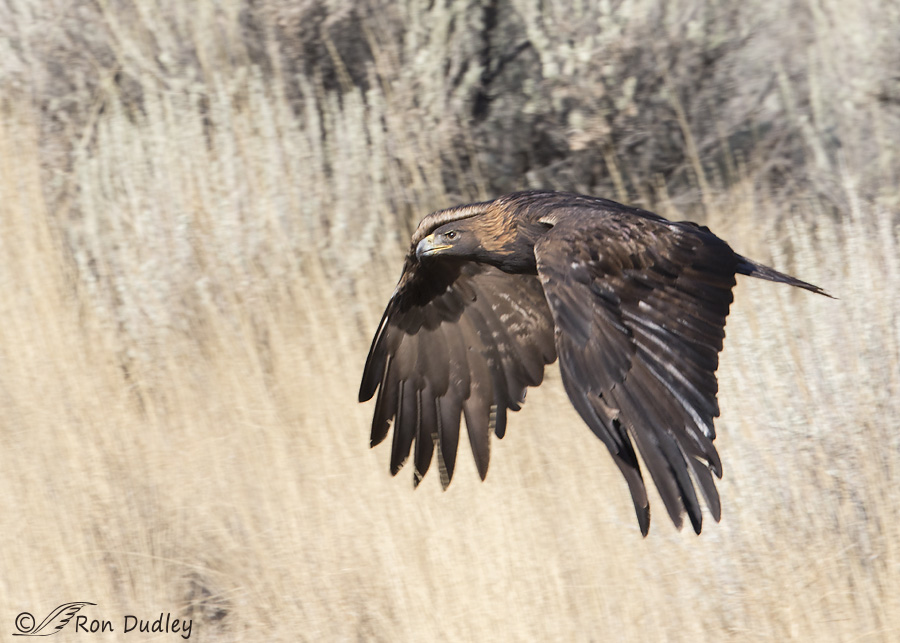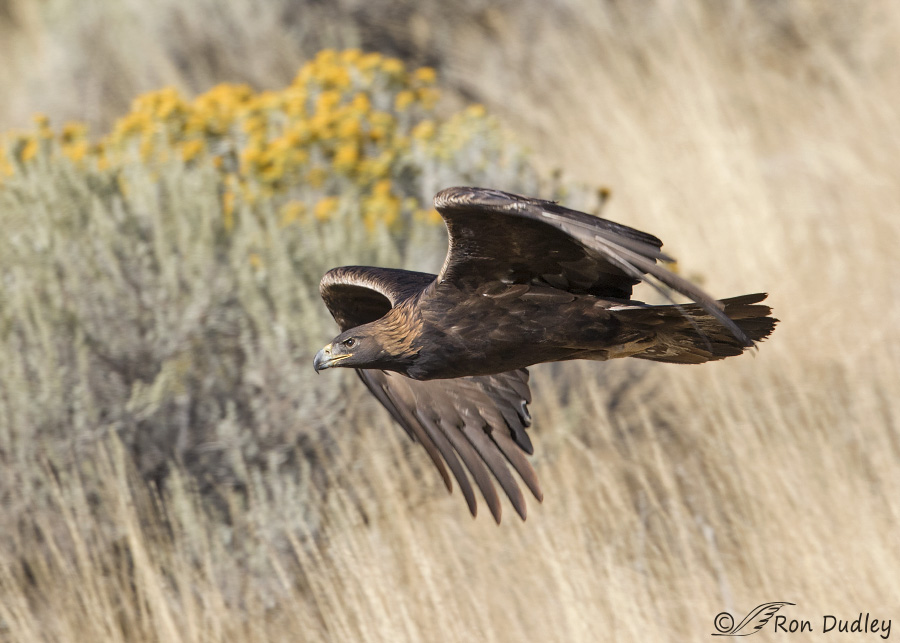Flawed images can still be of value to the photographer – they can teach us new lessons or remind us of old ones previously learned but temporarily forgotten in the heat of the moment. This photo of a Golden Eagle in flight taken about two months ago in Box Elder County is a case in point.

1/1000, f/7.1, ISO 640, Canon 7D Mark II, Canon EF 500mm f/4L IS II USM + EF 1.4 III Extender, not baited, set up or called in
I had high hopes for the image until I saw it on my screen. I immediately noticed that the head of the bird is just a little bit too soft for a quality presentation so I filed it away and moved on. To be honest I probably would have deleted it if it hadn’t been a Golden Eagle in flight. It isn’t bad but it isn’t very good either.
But last night I noticed something that escaped me on the first pass – both wings are much, much softer than the head. I was far enough away from this eagle that I didn’t think depth of field would be an issue but it obviously is since I have plenty of shutter speed to prevent motion blur on this large, slow-flapping species.
It had been a long time since I’d photographed an eagle in flight and I just didn’t think to allow for the incredible depth of their wingspan – up to and even exceeding 7 1/2 ft in Golden Eagles. Since I’m shooting at an effective 1120mm I had no chance to get the wings sharp at these camera settings (even if the head had been sharper) when they’re in this position.

1/1250, f/7.1, ISO 640, Canon 7D Mark II, Canon EF 500mm f/4L IS II USM + EF 1.4 III Extender, not baited, set up or called in
It might be interesting to compare the first image to this one of the same bird taken 10 frames (one second) later in the burst (I’ve posted this photo previously).
The entire bird is sharper but the wingtips are also soft, even though I had slightly higher shutter speed. But because of their position the softness of the wings doesn’t matter nearly so much – we see the entire body length of the bird and it’s sharp and the soft left wing doesn’t drape down in front of the body to take our attention away from the sharper parts of the eagle. I like this photo a lot – the first one, not so much.
So, the next time I’m photographing an eagle (of either species) in flight I’ll try to remember to allow for the incredible wingspan of these magnificent birds.
Ron


I am glad that you take photos of Golden Eagles because now I see the golden feathers and they are beautiful.Depth of field is such an issue with me as I discover with my lens at 300mm and have not been successful getting all of a chickadee sharp. I learned and am still learning that I must open the aperture more and hope for a reasonably bright day so I can get a fast-enough shutter speed.I did take note of your comment to Christine, thank you.Enjoy the learning curve!
To me, these are both beautiful shots of a beautiful Eagle.
They are great shots. You are just a perfectionist. ☺
Charlotte
Thanks, Charlotte. I don’t know about being a perfectionist but I do like my shots to be sharp. 🙂
Majestic magic.
And a challenge.
Thanks, EC.
Such beauties. I can’t wait until you get “the shot”. 😀 I know you will.
You have more faith than I do, Arwen. I have to keep reminding myself that the quest is part of the fun.
Ahhhh, Goldens. I think they may be my favorite of all the bird species. I remember that second shot — the overall composition, the light, the sense of purpose and power of this magnificent bird. I don’t think I even noticed the softness of the wing tips, although the seem to add to the sense of motion, in my opinion.
In the first photograph, whatever processing you did makes that gorgeous head clear as a bell to these old eyes. Plus, the softness and position of the wings serves to draw my eye to that eponymous golden nape. I wish you could hear the sigh of pure contentment that has escaped from me each time I’ve glanced at these shots this morning!
Your last sentence brought a smile, Marty. Sigh away!
Ah goldens…such beauty and grace. And yeah, I get all the kvetching, but I’d be delighted to have taken the first. And that’s why I don’t do photography 🙂
I still think you ought to TRY to get a shot of one of your birds coming straight at you before landing on your fist, Laura!
Love the light on his neck and head—in both, but especially in the second photo—the softness of the wings just enhances your depth perception.
Bobbi, I was delighted that the light you mention lit up that golden nape so well.
I am Happy to see any pictures you take, good or bad. Love them all! Thanks
Thanks very much, Trudy.
Ron, I’m impressed with what your eyes can see. Even zooming in on the first image, I’m not able to see that the head is soft (and that’s even with a brand new glasses prescription). Fortunately, I am able to see that the second image is a much better one, when I compare the two. The first one seems to be much softer overall. I think there’s way more hope for you getting better Golden Eagle shots than there is for my eyes to see them as they are.
Susan, I applied a little extra sharpening in post processing to the bird in the first image to hopefully make up for some of the softness. It’s much more apparent in the unprocessed version.
Just to have that rare opportunity is something to cherish. You might be kicking yourself if in that, from your perspective you did not “get it”, but, from my perspective, with the second image, you did! I just hope someday down the road I have the opportunity to “screw it up” with either of our eagles.
I hope you do too, Frank. I swear I’m not going to mess the next one up!
I always love anyimage of a Golden and still nd the second to be perfection….
Thanks, Patty. I figured you’d recognize that second photo!
It jumped right out at me….
WOw, Ron!! I know that you have problems with the 1st capture and I appreciate the lesson on depth of field in regard to these raptors with their amazing wingspan but — I have 3 words for these guys – stunning, majestic, stupendous!! Love eagles – bald or otherwise!!!!!
Agreed, Jo Ann – even my flawed photo doesn’t detract much from the magnificence of a Golden Eagle.
Beautiful even if the DOF was off a bit. I run into that even when the situation isn’t as fast moving as that! 🙂 Don’t know if a calculater would help since my sense of distance/depth perception aren’t that red hot! Still love the pictures. 🙂
Thank you, Judy.
Well, I’m sorry, I like the shots. I would be in heaven to be in the same company of that Golden!!
I understand the lesson and have run into the same problem, but I would have done the same, kept the shots.
Right or wrong, my ISO is below 1000 on sunny days and between 1000 and/or 1500-2000 on cloudy days at aperture priority unless I’m shooting movement.
But, sometimes all hell breaks loose when you least expect it, so when that happens I’m happy to get 1 decent shot! VBG!
“Right or wrong, my ISO is below 1000 on sunny days and between 1000 and/or 1500-2000 on cloudy days”
Dick, we do what we have to do to get the shot. I’m not sure which lens you’re shooting with but I may have the advantage in low light because my lens is an f/4 which would allow me faster shutter speeds than a slower lens.
Absolutely!
My excuse is that my lens is an old 400mm with extender with major vignetting problems. Have to crop the vignettes out!
OK, cool–thank you Ron 😉 Here’s hoping for more Goldens in your neck of the woods soon!
Thanks Ron. Always a hard lesson for me to remember in the heat of the moment with large birds. The distance to the subject is also a very big factor as you mention. The other day I intentionally stopped down to f/9 with 840mm focal length for a kingfisher at 30 meters, the wingspan of the kingfisher was large enough to give field blur even at f/9. Wish I had a built in depth of field calculator that could quickly remind me 🙂
“Wish I had a built in depth of field calculator that could quickly remind me”
That would be darned handy, wouldn’t it, Ed? I have to constantly remind myself of how ridiculously shallow our DOF is when shooting at these focal lengths.
Hello Ron, thanks for the post! Can you tell us what steps (e.g. camera settings) you would take to improve your chances for the shots you want? Other than finding another Golden in good light, in flight, etc. 😉
Christine, The answer to your question varies tremendously, depending on the situation. In the case of this Golden Eagle, please see my response to Christine B. below.
What depth of field setting would you rather have used and what is the max ISO setting you’d consider acceptable given your equipment?
Christine, I think about f/9 in this situation would have helped noticeably with DOF. With my camera I prefer to not exceed ISO 800, though I do occasionally when I have to.
They are my favorite seconds species after northern harriers. I think your images are awesome!!! I’m still trying to get the perfect golden eagle. I had a golden flush out of grass in front of me I was sooooo not prepared! Let alone have correct aperature setting.
Marina, if it makes you feel any better, screwing up opportunities with Golden Eagles is my specialty!